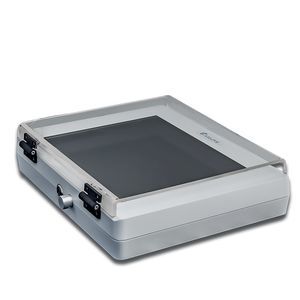
- Laboratory
- Physico-chemical analysis
- Electrophoresis transilluminator
- BENCHMARK SCIENTIFIC
Electrophoresis transilluminator SmartBlue™UVfluorescence
Add to favorites
Compare this product
Characteristics
- Applications
- for electrophoresis
- Light source
- UV, fluorescence
Description
Accuris SmartBlue Transilluminators have been developed for viewing DNA gels stained with new, safe fluorescent dyes. These new dyes, such as SmartGlow, SYBR Green, Gel Green, have an excitation wavelength of 465-470nm (visible blue light), and are safer to use than Ethidium Bromide.
Blue light, safe for nucleic acids
Uniform illumination (UI Technology)
Optimal wavelength (465nm) for common safe stains
Easily removable, two position amber filter cover
Optional amber viewing glasses: E4000-VG1
Safer for samples, safer for you: Accuris SmartBlue Transilluminators are the perfect partner for the most common safe DNA stains. It emits blue light at a wavelength of 465nm, perfect for excitation of most green fluorophors, including our Accuris’ SmartGlow™, SYBR Green, SYBR Safe, SYBR Gold, GelStar, GelGreen, to name a few. The SmartBlue can also works for excitation of EtBr (though fluorescence is not as bright as with UV), see our Technical Bulletin with sample images. Exposing DNA to blue wavelength does not cause molecular damage, and results in a much higher downstream cloning efficiency as compared to even short UV light exposures. In addition, the visible blue light is not damaging to the user’s skin and is less harmful to the eyes.*
Two position filter cover: Both the E4100 and E4000 transilluminators come with emission filter covers. These amber covers, which rest above the viewing surface and gel, filter out the blue light, allowing the fluorescinc DNA bands to be seen clearly.
Catalogs
myVolt™
2 Pages
InstaView™
4 Pages
Related Searches
- Automatic scale
- BENCHMARK laboratory balance
- BENCHMARK electronic laboratory balance
- BENCHMARK benchtop laboratory balance
- Laboratory balance with digital display
- Spectrophotometer
- Precision laboratory balance
- Laboratory balance with LCD display
- Medical laboratory balance
- Automatic laboratory balance
- Benchtop spectrophotometer
- Teaching laboratory balance
- UV-vis spectrophotometer
- Electrophoresis system
- Analytical laboratory balance
- Benchtop electrophoresis system
- Transilluminator
- Gel reader
- VIS spectrophotometer
- Electrophoresis transilluminator
*Prices are pre-tax. They exclude delivery charges and customs duties and do not include additional charges for installation or activation options. Prices are indicative only and may vary by country, with changes to the cost of raw materials and exchange rates.















